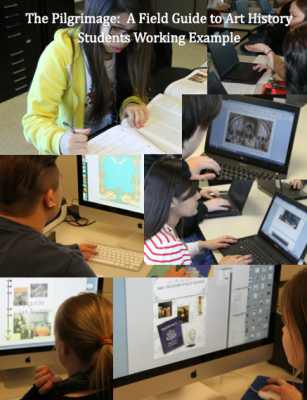Summary
The Pilgrimage is a journey for students and teachers alike; exploring and compiling art historical information in a scientific way that initiates discovery and excitement. What could be more motivating than learning about great story and passing it on to others?
The aim of this lesson is to untangle the sociological, political, religious and personal factors behind art and organize them in a manageable format similar to field guides in science. This method was chosen to deepen observational skills. Critical thinking is required to make connections and comparisons.
Students use higher order thinking skills: organizing, deconstructing, explaining and producing to ultimately create a field guide book and e-book to help others in identifying art and aid in the understanding of history and the contemporary world around them.
TIPC Ratings
Approaching: Because the instructor guides students through the process of categorizing and organizing in a manner indicative of a Field Guide. The teacher aids students in understanding the importance of research and challenges them to share in the painstaking process researchers take to compile and publish reliable information. The assignment provides the students an opportunity to develop a real-world application with a final product. This is used not only to promote the arts in education but in the understanding and of other disciplines demonstrated through a cross-curricular approach. The teacher supports students, by moving around the room, as they acquire their information and help to direct them in evaluating whether to include it in our book. Students use the internet to conduct their research but determine on their own the validity of the information and sources through comparisons. Other research tools were given.
Approaching: Because students collaborated in peer groups to research and create the strategy and details of a Field Guide book. The students used advanced technologies, such as Adobe CS, to create original and purposeful work. Students sorted through published expert field guides and collaboratively critiqued historical content, layout and design as well as each other. It is the ultimate collaboration to take five different art classes consisting of 150 students and create a single book. This lesson goes beyond the classroom in that students are communicating to a world audience with their dissection of Art History in a formal scientific manner. This approach is somewhat unusual for an art historian, I even dare to say, new. The information, regardless of time or distance, will ultimately reach the hands hundreds, perhaps someday thousands of people via a published book, e-book and eventually smartphone app. These students are not only communicating presently but will continue to do so across time and boundaries through both old and new technologies.
Ideal/ Target: Students were engaged in an environment with meaningful questioning strategies. This project encourages the exploration of scientific procedures and how to apply them to other aspects of their learning. Students were responsible for judging and evaluating their own research sources throughout the entire project. Connections with the past and present were made and through technology and those associations were created and presented. Students were challenged to reflect on their product, their process, as well as those of their peers. High order thinking such as synthesis, analysis and evaluation were required to develop a complete guide to art history. The final product was authentic, meaningful, creative, and useful.
Ideal/Target: Because the teacher facilitated an environment where students were engaged in the creation of an innovative new project. Creativity was abundant in the design, layout and publication of their book. Students experimented with various techniques based on current trends and were prompted by them to move beyond the classroom and take the project “viral”. Outside the parameters of the assignment students are currently looking into publishing our guide as an e-book and app development. The students were engaged in higher order thinking synthesizing the information to compose, design, create and produce a book. Furthermore, students were required to figure out how to work with 150 of their classmates to coordinate and ensure that all outcomes were successful. Throughout the process student suggestions were recommended such as various research techniques, scientific studies and technological applications and student solutions were implemented for example layout changes, design ideas and sharing of information. Additionally, the students created an innovative product that has value for a variety of specified audiences.





